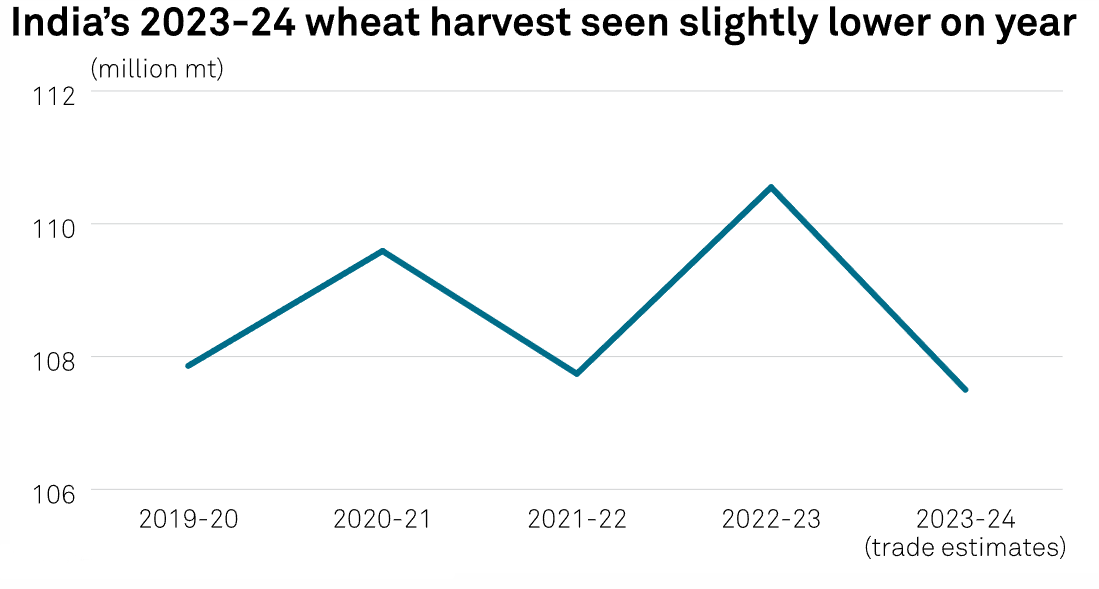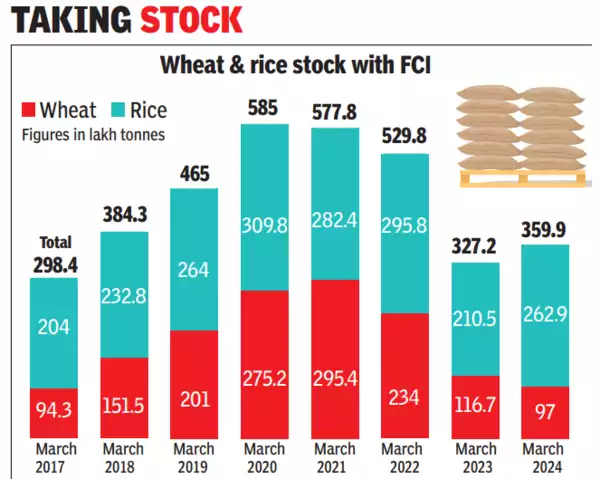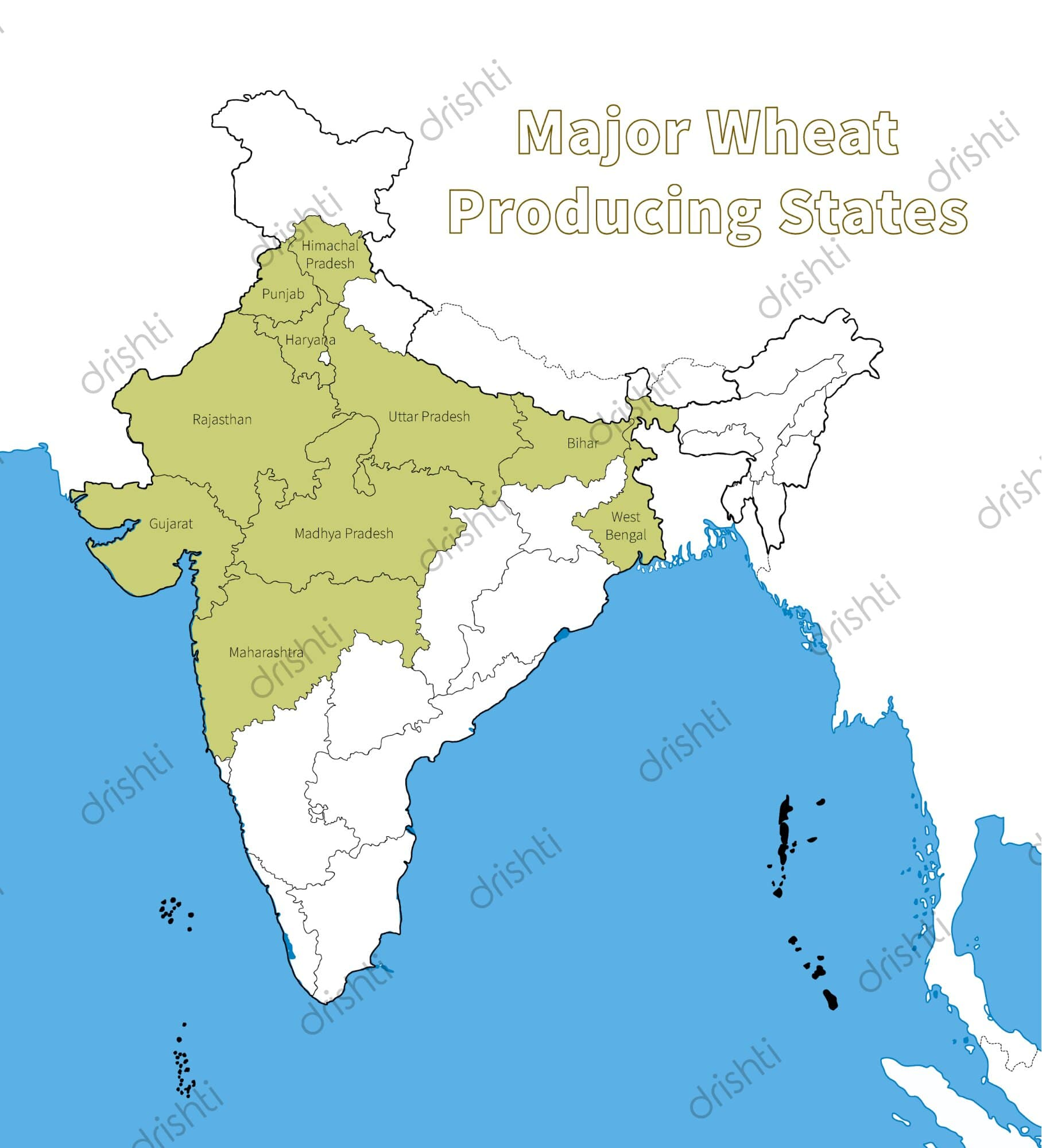Indian Economy
India to Import Wheat After 6 years
- 01 Jun 2024
- 9 min read
For Prelims: Food inflation, Wheat, Food Crops, Buffers Stocks, Minimum Support Prices.
For Mains: Effects of Weather in Food Production, Foodgrain Security.
Why in News?
India, the world's second-largest wheat producer, plans to begin wheat imports after a six-year gap to replenish depleted reserves and control rising prices, driven by three consecutive years of disappointing crops.
- India is likely to remove a 40% import tax on wheat, allowing private traders to purchase from countries like Russia, though in small quantities.
Why India Decided to Resume Wheat Imports?
- Declining Wheat Production:
- India's wheat production has declined in the last 3 years due to unfavourable weather conditions, leading to a sharp drop in wheat output.
- The government estimates this year's wheat crop to be 6.25% lower than the previous year's (2023) record production of 112 million metric tons.
- Depletion of Wheat Reserves:
- As of April 2024, wheat stocks in government warehouses have dropped to 7.5 million tons, the lowest in 16 years, due to the government selling over 10 million tons from its reserves to control domestic prices.
- Shortfall in Wheat Procurement by Government:
- The government's target for wheat procurement the year 2024 was 30-32 million metric tons, but it has managed to buy only 26.2 million tons so far.
- Surge in Domestic Wheat Prices:
- Domestic wheat prices have stayed above the government's minimum support price (MSP) of 2,275 rupees per 100 kg and have been on the rise recently.
- So, the government decided to remove the 40% import duty on wheat to allow private traders and flour millers to import wheat, primarily from Russia.
- Domestic wheat prices have stayed above the government's minimum support price (MSP) of 2,275 rupees per 100 kg and have been on the rise recently.
What are the Possible Implications of the Decision?
- Domestic Market:
- Enhanced Availability and Price Stability: Abolishing import duty will likely lead to increased wheat supplies in the domestic market. This can potentially mitigate price hikes.
- Replenishing Strategic Reserves: Lower import costs can aid the government in replenishing depleted wheat reserves. This bolsters food security by creating a buffer against unforeseen disruptions in domestic production.
- Global Market:
- Potential Upward Price Pressure: While India's estimated import volume (3-5 million metric tons) is modest, it could contribute to a rise in global wheat prices.
- This is due to the current scenario of high prices driven by production concerns in major exporting nations like Russia.
- Limited Overall Impact: India's import requirement is unlikely to significantly influence the global market. Larger players will continue to exert a more substantial influence on global wheat price trends.
- Potential Upward Price Pressure: While India's estimated import volume (3-5 million metric tons) is modest, it could contribute to a rise in global wheat prices.
Food Corporation of India (FCI)
- It is a statutory body established under the Food Corporations Act 1964.
- Functions under the Department of Food & Public Distribution, Ministry of Consumer Affairs, Food and Public Distribution.
- Key Functions of FCI:
- Procurement: FCI acts as the nodal agency for procuring wheat and paddy at the government-declared Minimum Support Price (MSP) to safeguard farmers' interests and incentivise agricultural production.
- Storage: The procured food grains are stored scientifically in warehouses across the country to maintain buffer stocks and ensure availability during lean periods.
- Distribution: FCI efficiently distributes foodgrains to state governments for further distribution through the Public Distribution System (PDS). This ensures access to essential food items at subsidised prices for vulnerable sections of society.
- Market Stabilisation: By regulating procurement and distribution, FCI helps stabilise foodgrain prices in the market, preventing undue price fluctuations.
- Monitoring: FCI closely monitors foodgrain stocks and their movement throughout the country to identify potential shortages and ensure timely corrective measures.
Wheat
- This is the second most important cereal crop in India after rice and main food crop, in the north and north-western part of the country.
- Wheat is a rabi crop that requires a cool growing season and bright sunshine at the time of ripening.
- Success of the Green Revolution contributed to the growth of Rabi crops, especially wheat.
- Temperature: Between 10-15°C (Sowing time) and 21-26°C (Ripening & Harvesting) with bright sunlight.
- Rainfall: Around 75-100 cm.
- Soil Type: Well-drained fertile loamy and clayey loamy (Ganga-Satluj plains and black soil region of the Deccan).
- Top 3 Wheat Producers in World (2021): China, India and Russia.
- Top 3 Wheat Producers in India (in 2021-22): Uttar Pradesh, Madhya Pradesh and Punjab
- Status of Indian Wheat Production and Export:
- India is the world's second-biggest wheat producer after China. But it accounts for less than 1% of the global wheat trade. It keeps a lot of it to provide subsidised food for the poor.
- Its top export markets are Bangladesh, Nepal, Sri Lanka
- Government Initiatives:
- Macro Management Mode of Agriculture, National Food Security Mission and Rashtriya Krishi Vikas Yojana etc.
Conclusion
India's decision to resume wheat imports after a 6-year gap is a pragmatic move to address the domestic supply and price concerns arising from declining wheat production and depleted government reserves.
While the imports may have a moderate impact on global wheat prices, the primary focus for the Indian government is to ensure food security and price stability for its citizens.
|
Drishti Mains Question: India is the world's second-largest producer of wheat, yet it frequently resorts to wheat imports. Critically examine the factors contributing to this situation and suggest policy measures to achieve greater self-sufficiency in wheat production. |
UPSC Civil Services Examination, Previous Year Question (PYQ)
Prelims
Q. With reference to the provisions made under the National Food Security Act, 2013, consider the following statements: (2018)
- The families coming under the category of ‘below poverty line (BPL)’ only are eligible to receive subsidised food grains
- The eldest woman in a household, of age 18 years or above, shall be the head of the household for the purpose of issuance of a ration card.
- Pregnant women and lactating mothers are entitled to a ‘take-home ration’ of 1600 calories per day during pregnancy and for six months thereafter.
Which of the statements given above is/are correct?
(a) 1 and 2 only
(b) 2 only
(c) 1 and 3 only
(d) 3 only
Ans: (b)
Q. Consider the following crops:
- Cotton
- Groundnut
- Rice
- Wheat
Which of these are Kharif crops?
(a) 1 and 3
(b) 2 and 3
(c) 1, 2 and 3
(d) 2, 3 and 4
Ans: (c)
Mains
Q. Hunger and Poverty are the biggest challenges for good governance in India still today. Evaluate how far successive governments have progressed in dealing with these humongous problems. Suggest measures for improvement. (2017)
Q. What are the reformative steps taken by the Government to make the food grain distribution system more effective? (2019)








